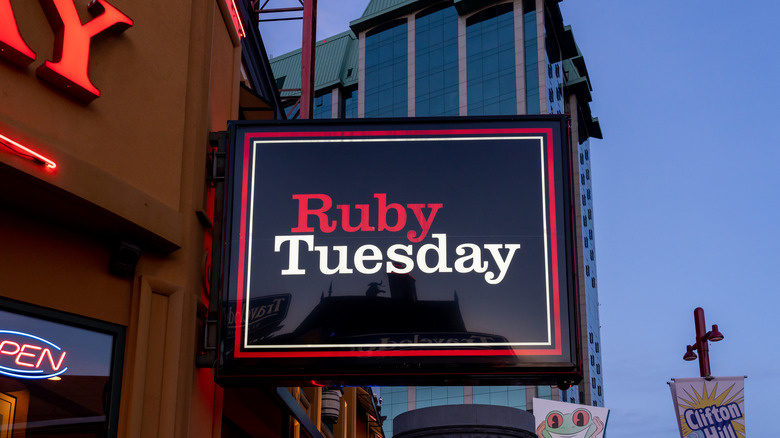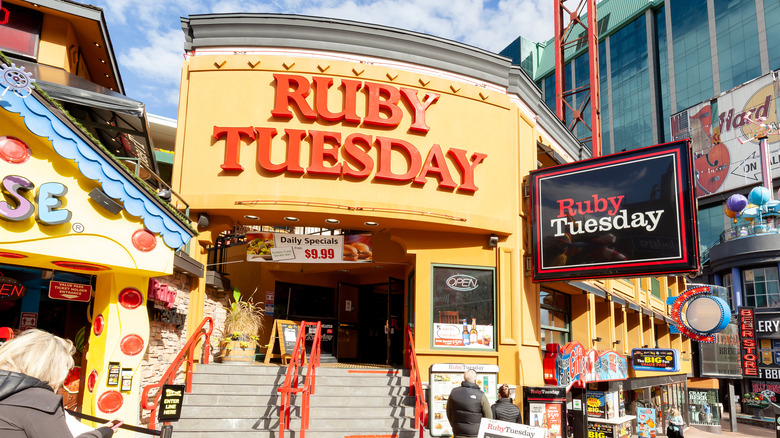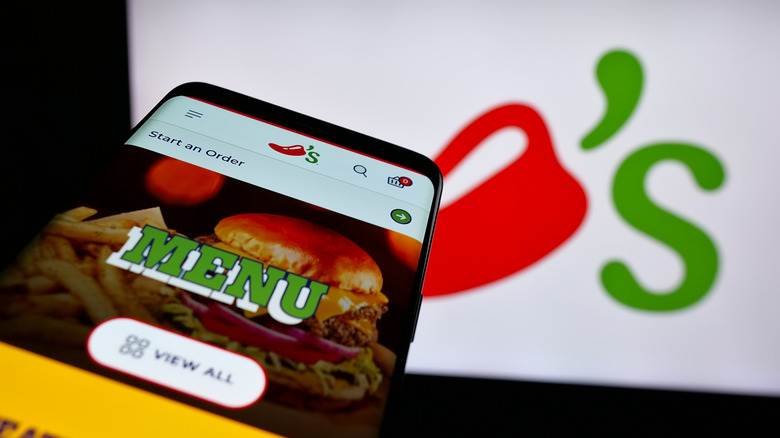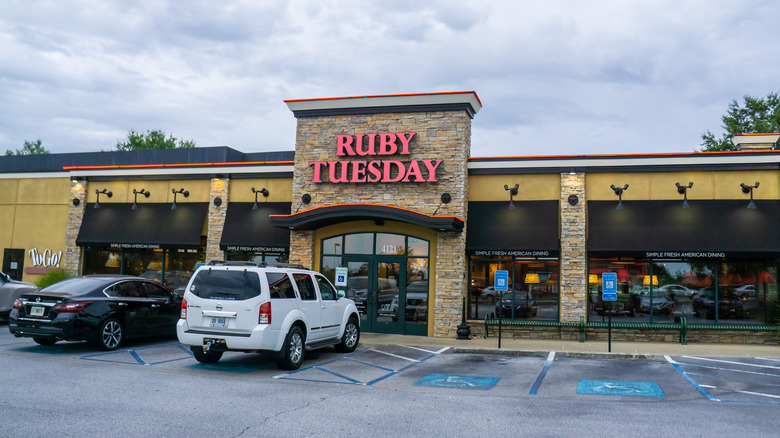The Real Reason Ruby Tuesday Is On The Decline
It turns out, "goodbye, Ruby Tuesday" isn't just a song lyric. Any remaining loyal customers of the restaurant chain that shares its name with the Rolling Stones classic find themselves saying farewell again and again as locations continue to close, and the struggling brand fails to find its footing. Things are so bad that there reportedly is only one Ruby Tuesday left in the entire state of Connecticut.
Things weren't always this bad. In the early 2000s, Ruby Tuesday was at its peak. The company's stock traded comfortably above $30 per share, and it operated more than 900 locations across the United States. But it was actually around this time that things began to drift off-course. Sales began to decline around 2006. The chain's attempts to regain momentum resulted in a series of moves that failed to generate traction with customers. According to Fortune, Ruby Tuesday agreed to sell itself to NRD Capital Management in 2017. The $146 million acquisition was preceded by more the closing of over 100 locations. The move also made the brand privately owned; despite past stock success, it would never again be a publicly traded business. And still, this was not enough to turn things around for Ruby Tuesday.
A series of mistakes coupled with the inability to navigate the post-COVID-19 economic climate has forced Ruby Tuesday to shrink its reach, aim lower, and hope for the best, even as things continue to fail to improve. Though many theorize and debate what went wrong for this brand, a large-scale overlook of marketing may be largely to blame for Ruby Tuesday's decline.
Where Ruby Tuesday ran into trouble
Ruby Tuesday's growth and expansion largely relied on an American population that had the extra income to afford a sit-down restaurant dining experience and the desire to spend their money that way. One could argue that the earnings drop-off in 2006 was the first sign of trouble on that front, confirmed in 2008 when the United States entered the Great Recession. This era saw Americans forced to rearrange their spending habits, with some trading restaurant experiences for effectively marketed fast food dollar menus. It was a shift that also saw the growth of so-called "fast-casual" restaurants like Chipotle and Panera Bread, whose rise in status saw more traditional staples like Ruby Tuesday lose significant market share.
While some competitors like Chili's and Texas Roadhouse were eventually able to correct course and recover, Ruby Tuesday made a series of bizarre decisions that only amplified how off-pace the brand was. Ruby Tuesday decided to deprioritize menu items like burgers and ribs in favor of lobster. The New York Times even titled its observation, "At Ruby Tuesday, casual dining dons a blazer." If the hope was that a shift to upscale dining with higher prices would bring in wealthier clientele, it was quickly met with disappointment. Through the 2010s, the restaurant chain experienced multiple changes in leadership, the selling off of subsidiaries, and then dozens of locations closed, according to Restaurant Business.
In 2020, Ruby Tuesday found itself with no alternative but to file for Chapter 11 bankruptcy. Already on the decline, Ruby Tuesday's decision came just ahead of the impending COVID-19 era restrictions that would come to devastate Ruby Tuesday along with the entire dine-in restaurant industry.
How a lack of advertising may be to blame for Ruby Tuesday's decline
The one area of business where Ruby Tuesday is falling behind competitors is in its advertising. Per MediaRadar, the company spent less than $100 million in digital and national TV ads over the past year. MediaRadar also noted the company hadn't advertised any new products since October 2024. As Ruby Tuesday is focused on running a leaner, healthier company, it would at first make sense to stop spending in areas that aren't necessary to the brand's future survival. However, one could argue that if there is any area of spending that might be more important than ever to Ruby Tuesday at the moment, it's the company's ad spending.
According to MediaMax, top businesses desiring visibility and success will devote at least 10% of their revenue to advertising, with larger companies reportedly aiming for at least 13% of their budget. As Sanmit Chatterjee notes in his Emeritus article, "Importance of Advertising for Growing Your Business: The Ultimate Guide," advertising is extremely important for companies operating in a contemporary professional landscape. Chatterjee argued that advertising is a component that is an essential engagement strategy for businesses seeking to engage with their audiences, necessary for showcasing not only products and services, but what's at the heart of their core values.
Ruby Tuesday's ad spending may be low, but the brand has made some strides to get in front of customers. That said, most of its focus seems to be digital, as MediaRadar reports the company bought a digital video ad and has partnered with Google. It might be that the restaurant chain doesn't see the value in offline advertising and believes it can save money through strictly online pursuit of visibility. But as it has yet to catch competitors like Chili's, a more aggressive advertising campaign from Ruby Tuesday may be unavoidable if the brand is to halt its decline.
Chili's is winning the advertising war with Ruby Tuesday
While some argue that Ruby Tuesday isn't doing enough advertising, the same cannot be said for rival Chili's. As Fortune reports, Chili's spent more than $105 million on advertising campaigns over three years, with much of its time and money drawing customer attention to its 3 for Me value meal. Restaurant Business wrote that the meal deal, which starts at $10.99, comes with an appetizer, entrée, and one non-alcoholic beverage. Chili's also made a strong effort to get the word out about the new Big Smasher burger, reportedly designed to be direct competition for McDonald's Big Mac.
The money Chili's invested in extensive advertising has paid off, as the restaurant chain saw a 24% spike in sales and a 16% jump in overall foot traffic during the most recent quarter, per the Fortune article. It is an upward trend that shows Chili's is being rewarded for paying attention to what excites its customers and spending the necessary ad revenue in ways that ensure the word reaches the public about what it's doing, what's new, and what there is to be excited about.
Whether Ruby Tuesday can afford to outspend Chili's at the moment is debatable, as is the company's will to do so. But one thing is for certain: If Ruby Tuesday can't get the word out about its menu items with the same vigor and efficiency as Chili's then it will only continue to lose ground to its biggest chain rivals.
How competitor success impacts Ruby Tuesday
Perhaps making things worse for Ruby Tuesday isn't the big campaign wins that Chili's is currently enjoying, but rather, that the most popular sit-down restaurant in America, Texas Roadhouse, earned its place at the top while allegedly devoting no more than 1% of its overall revenue to its marketing budget, as Market Realist data shows. It's a decision that, at first glance, defies all business logic and hope of success. However, it's not that Texas Roadhouse doesn't market its brand, it's that they've taken a less-than traditional, but no less effective approach.
Instead of focusing on a nationalized advertising strategy in the same way that Ruby Tuesday and Chili's does, Texas Roadhouse instead connects with customers at the local level. This involves community based events and engagement. The company has spent years embedding itself in the surrounding region, ensuring that nearby customers are so comfortable and familiar with the chain, that they need not look to TV or internet to know where to go or why. It's an unusual approach, but it continues to work. It would seem that between Chili's sensible use of advertising spending and Texas Roadhouse's stripped down, but nonetheless efficient approach, Ruby Tuesday's competition has effectively figured out how to capitalize on ways that push their own chains forward while leaving Ruby Tuesday to struggle through its ongoing decline.
What's next for Ruby Tuesday?
As of late 2025, Ruby Tuesday continues to endure closures. Since the pandemic, the restaurant chain has closed at least 185 restaurants, per an NPR report. While the entire industry continues to cope in the wake of COVID-19, social media posts suggest that the public isn't too impressed with the brand, citing poor food quality, rude restaurant staff, and inappropriately high prices as reasons they continue to stay away. It's a series of reactions that signal not only how far Ruby Tuesdays has fallen, but also how far removed the brand is from its early days of catering to young and financially struggling college students, and later courting families seeking a casual, yet affordable, dining experience. It signals that despite Ruby Tuesdays efforts, the restaurant guests it seeks have formed enough of a negative opinion that as things stand, these reluctant customers may never come back.
The only realistic way to reverse course may be to step up advertising efforts and try to get Americans to see Ruby Tuesday in a new light. Without any such efforts, many experts believe that it's only a matter of time before Ruby Tuesdays closes its doors permanently.





